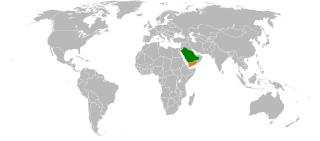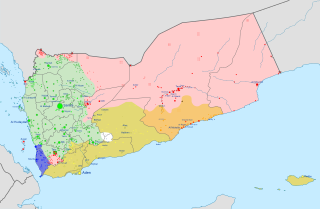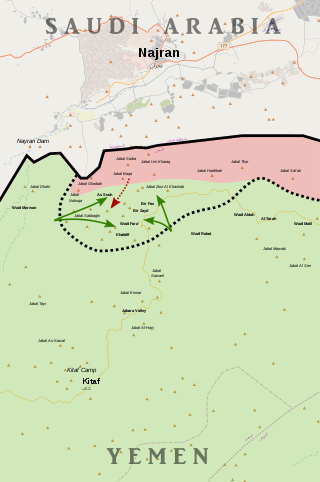
The history of Saudi Arabia as a nation state began with the emergence of the Al Saud dynasty in central Arabia in 1727 and the subsequent establishment of the Emirate of Diriyah. Pre-Islamic Arabia, the territory that constitutes modern Saudi Arabia, was the site of several ancient cultures and civilizations; the prehistory of Saudi Arabia shows some of the earliest traces of human activity in the world.

The history of Yemen describes the cultures, events, and peoples of what is one of the oldest centers of civilization in the Near East. Its relatively fertile land and adequate rainfall in a moister climate helped sustain a stable population, a feature recognized by the ancient Greek geographer Ptolemy, who described Yemen as Eudaimon Arabia meaning "fortunate Arabia" or "Happy Arabia". Yemenis had developed the South Arabian alphabet by the 12th to 8th centuries BC, which explains why most historians date all of the ancient Yemeni kingdoms to that era.

Yemen, officially the Republic of Yemen, is a country in West Asia. It is located in the southern end of the Arabian Peninsula, bordering Saudi Arabia to the north and Oman to the northeast. It shares maritime borders with Eritrea, Djibouti and Somalia. Covering 530,000 square kilometres and having a coastline of approximately 2,000 kilometres, Yemen is the second-largest Arab sovereign state on the Arabian Peninsula. Sanaa is its constitutionally stated capital and largest city. The country's population is estimated to be 34.7 million as of 2023. Yemen is a member of the Arab League, the United Nations, the Non-Aligned Movement and the Organisation of Islamic Cooperation.

Al Hudaydah, also transliterated as Hodeda, Hodeida, Hudaida or Hodeidah, is the fourth-largest city in Yemen and its principal port on the Red Sea and it is the centre of Al Hudaydah Governorate. As of 2023, it has an estimated population of 735,000.

Najran, is a city in southwestern Saudi Arabia near the border with Yemen. It is the capital of Najran Province. Designated as a new town, Najran is one of the fastest-growing cities in the kingdom; its population has risen from 47,500 in 1974 and 90,983 in 1992 to 246,880 in 2004 and 381,431 in 2021. The population mostly originates from the ancient tribes of Yām, Mákram, and Hamdan.

The Kingdom of Yemen, officially the Mutawakkilite Kingdom of Yemen, or simply as Yemen, or, retrospectively, as North Yemen, was a state that existed between 1918 and 1962 in the northwestern part of what is now Yemen. Located in the Middle East, the Kingdom of Yemen had an area of 195,000 km2. The country was bordered by Saudi Arabia in the north, and the Aden Protectorate to the south. Its capital was Sana'a from 1918 to 1948, then Taiz from 1948 to 1962. Yemen was admitted to the United Nations on 30 September 1947. From 1962 to 1970, it maintained control over portions of Yemen until its final defeat in the North Yemen Civil War.

South Arabia is a historical region that consists of the southern region of the Arabian Peninsula in Western Asia, mainly centered in what is now the Republic of Yemen, yet it has also historically included Najran, Jizan, Al-Bahah, and 'Asir, which are presently in Saudi Arabia, and the Dhofar of present-day Oman.

The Saudi–Yemeni War was a war between Saudi Arabia and the Kingdom of Yemen in 1934.

Jewish history in the territory of modern Saudi Arabia begins in classical antiquity.

The Unification of Saudi Arabia was a military and political campaign in which the various tribes, sheikhdoms, city-states, emirates, and kingdoms of most of the central Arabian Peninsula were conquered by the House of Saud, or Al Saud. Unification started in 1902 and continued until 1932, when the Kingdom of Saudi Arabia was proclaimed under the leadership of Abdulaziz, known in the West as Ibn Saud, creating what is sometimes referred to as the Third Saudi State, to differentiate it from the Emirate of Diriyah, the First Saudi State and the Emirate of Nejd, the Second Saudi State, also House of Saud states.

The Idrisid Emirate of Asir was a state located in the Arabian Peninsula. The Emirate was in the geographical region of Asir and Jizan, in what is now southwestern Saudi Arabia, and extending to Hodeidah, northwest of Yemen.

Saudi Arabia and Yemen relations refers to the current and historical relationship between the neighbouring sovereign states of Saudi Arabia and Yemen. The two countries at one time did enjoy good relations and closely cooperated in military, economic and cultural issues. Now because of the ongoing Yemeni Civil War and the realignments of power in the Middle East with the emergence of al-Qaeda and the radicalization of some factions of Islam, Saudi Arabia has led a military intervention into Yemen.
The al-Wadiah War was a military conflict which broke out on 27 November 1969 between Saudi Arabia and the People's Republic of South Yemen (PRSY) after disputes for the town of al-Wadiah on the PRSY-Saudi Arabian border. The conflict ended on 6 December when Saudi forces captured al-Wadiah.

The Houthi–Saudi Arabian conflict is an ongoing armed conflict between the Royal Saudi Armed Forces and Iran-backed Yemeni Houthi forces that has been taking place in the Arabian Peninsula, including the southern Saudi regions of Asir, Jizan, and Najran, and northern Yemeni governorates of Saada, Al Jawf, and Hajjah, since the onset of the Saudi Arabian-led intervention in Yemen in 2015.

The Yemeni–Ottoman conflicts were a series of conflicts between the Ottoman Empire and Zaidi tribes in Upper Yemen, which began in 1538 and ended with the signing of the Treaty of Daan on 9 October 1911.

From late August to late September 2019, a military operation was carried out by Yemeni forces loyal to the Houthi-led Supreme Political Council, under the code name "Victory from God". It targeted Saudi Arabia and allied forces along the Saudi Arabia–Yemen border.
The Najran conflict was a poorly documented conflict over Najran in the early 1930s fought between the Mutawakkilite Kingdom of Yemen and the Kingdom of Hejaz and Nejd.

The Saudi Arabia–Yemen border is 1,307 km (812 mi) in length and runs from the Red Sea coast in the west to the tripoint with Oman in the east.

The Declaration of theUnification of Saudi Arabia was officially announced by Prince Faisal bin Abdulaziz, the Viceroy of Hejaz on behalf of King Abdulaziz ibn Saud on September 23, 1932, at 9:00 am from al-Hamidiyah Palace in Mecca. Faisal read out the Royal Decree No. 2716 issued by Abdulaziz ibn Saud on September 18, 1932, that renamed the Kingdom of Hejaz and Nejd and its annexes as the Kingdom of Saudi Arabia.

















